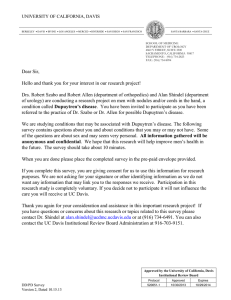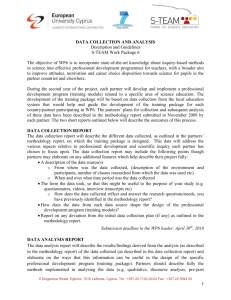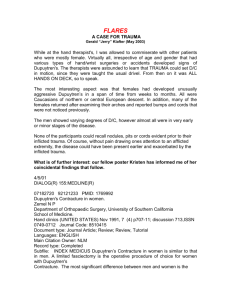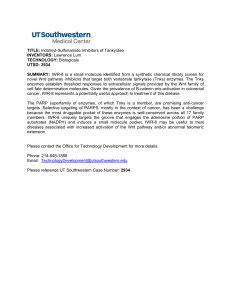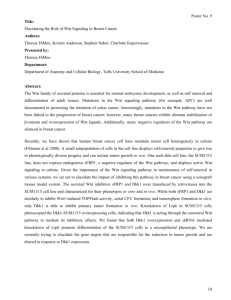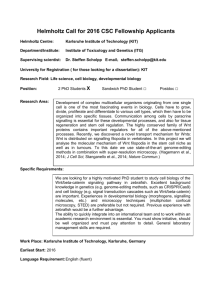Wnt Signaling and Dupuytren’s Disease
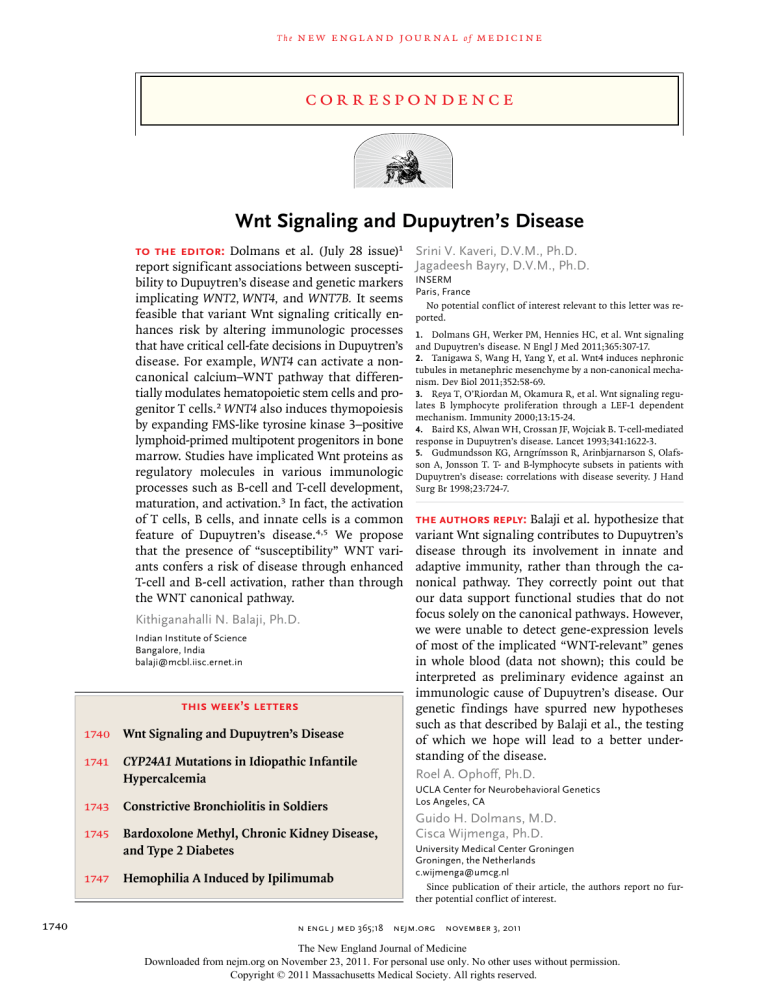
T h e
ne w e ngl a nd jou r na l o f
m e dicine c o r r e s p o n d e nc e
1740
Wnt Signaling and Dupuytren’s Disease
1740
1741
1743
1745
1747
To the Editor: Dolmans et al. (July 28 issue) 1 report significant associations between susceptibility to Dupuytren’s disease and genetic markers implicating WNT2, WNT4, and WNT7B. It seems feasible that variant Wnt signaling critically enhances risk by altering immunologic processes that have critical cell-fate decisions in Dupuytren’s disease. For example, WNT4 can activate a noncanonical calcium–WNT pathway that differentially modulates hematopoietic stem cells and progenitor T cells.
2 WNT4 also induces thymopoiesis by expanding FMS-like tyrosine kinase 3–positive lymphoid-primed multipotent progenitors in bone marrow. Studies have implicated Wnt proteins as regulatory molecules in various immunologic processes such as B-cell and T-cell development, maturation, and activation.
3 In fact, the activation of T cells, B cells, and innate cells is a common feature of Dupuytren’s disease.
4,5 We propose that the presence of “susceptibility” WNT variants confers a risk of disease through enhanced
T-cell and B-cell activation, rather than through the WNT canonical pathway.
Kithiganahalli N. Balaji, Ph.D.
Indian Institute of Science
Bangalore, India balaji@mcbl.iisc.ernet.in
this week’s letters
Wnt Signaling and Dupuytren’s Disease
CYP24A1 Mutations in Idiopathic Infantile
Hypercalcemia
Constrictive Bronchiolitis in Soldiers
Bardoxolone Methyl, Chronic Kidney Disease, and Type 2 Diabetes
Hemophilia A Induced by Ipilimumab
Srini V. Kaveri, D.V.M., Ph.D.
Jagadeesh Bayry, D.V.M., Ph.D.
INSERM
Paris, France
No potential conflict of interest relevant to this letter was reported.
1. Dolmans GH, Werker PM, Hennies HC, et al. Wnt signaling and Dupuytren’s disease. N Engl J Med 2011;365:307-17.
2. Tanigawa S, Wang H, Yang Y, et al. Wnt4 induces nephronic tubules in metanephric mesenchyme by a non-canonical mechanism. Dev Biol 2011;352:58-69.
3. Reya T, O’Riordan M, Okamura R, et al. Wnt signaling regulates B lymphocyte proliferation through a LEF-1 dependent mechanism. Immunity 2000;13:15-24.
4.
5.
Baird KS, Alwan WH, Crossan JF, Wojciak B. T-cell-mediated response in Dupuytren’s disease. Lancet 1993;341:1622-3.
Gudmundsson KG, Arngrímsson R, Arinbjarnarson S, Olafsson A, Jonsson T. T- and B-lymphocyte subsets in patients with
Dupuytren’s disease: correlations with disease severity. J Hand
Surg Br 1998;23:724-7.
The Authors Reply: Balaji et al. hypothesize that variant Wnt signaling contributes to Dupuytren’s disease through its involvement in innate and adaptive immunity, rather than through the canonical pathway. They correctly point out that our data support functional studies that do not focus solely on the canonical pathways. However, we were unable to detect gene-expression levels of most of the implicated “WNT-relevant” genes in whole blood (data not shown); this could be interpreted as preliminary evidence against an immunologic cause of Dupuytren’s disease. Our genetic findings have spurred new hypotheses such as that described by Balaji et al., the testing of which we hope will lead to a better understanding of the disease.
Roel A. Ophoff, Ph.D.
UCLA Center for Neurobehavioral Genetics
Los Angeles, CA
Guido H. Dolmans, M.D.
Cisca Wijmenga, Ph.D.
University Medical Center Groningen
Groningen, the Netherlands c.wijmenga@umcg.nl
Since publication of their article, the authors report no further potential conflict of interest.
n engl j med 365;18 nejm.org november 3 , 2011
The New England Journal of Medicine
Downloaded from nejm.org on November 23, 2011. For personal use only. No other uses without permission.
Copyright © 2011 Massachusetts Medical Society. All rights reserved.
